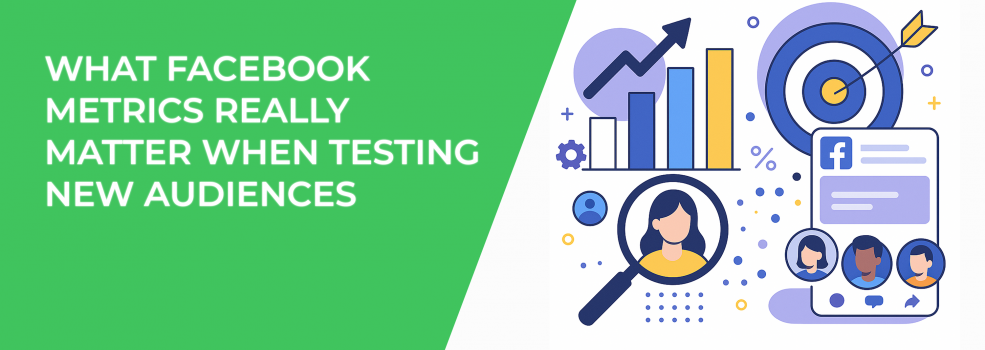Testing new audiences on Facebook or Instagram can feel overwhelming. Ads Manager gives you more data than most dashboards, but that doesn’t mean all of it matters. If you’re not tracking the right metrics, you risk burning your budget without learning anything useful.
So how do you separate the signals from the noise?
Here’s a breakdown of the Facebook metrics that truly matter when testing new audiences and how to make smarter decisions based on them.
1. Focus on Landing Page Views, Not Just Clicks
Link clicks look promising at first, but they don’t tell you if someone actually made it to your website or engaged with it. Many users click, then leave before the page even loads.
Use these more reliable engagement signals:
-
Landing Page Views — this shows users who waited for the destination to load.
-
Time on Page and Scroll Depth — use Google Analytics or Meta Pixel events to track whether users are engaging meaningfully.
-
On-Ad Engagement — comments, shares, and saves indicate your ad resonated beyond surface-level interest.
Tip: use UTM tracking to trace each audience segment’s behavior post-click. Combine this with tools like heatmaps or session recordings for deeper insights.
2. Don’t Judge Success by Cost Per Result Alone
A low cost per lead or purchase might seem like a win, but not all results are equally valuable. You need to understand what happens after the conversion.
Here’s what to watch instead:
-
Lead Quality — use tags or fields in your CRM to monitor how each segment performs after signup.
-
Customer Lifetime Value (LTV) — some audiences cost more upfront but are worth it long-term.
-
Funnel Completion Rates — see how users progress from click to purchase or signup confirmation.
Tip: match ad-level data with downstream revenue, not just short-term metrics. Look at the full customer journey to get the full picture.
If your ads aren't converting even when costs look decent, the issue might lie in deeper targeting or funnel alignment. Explore how to fix underperforming campaigns in our guide: Facebook Ads Not Converting: How To Fix It.
3. Keep a Close Eye on Frequency
Frequency — the average number of times someone sees your ad — rises quickly when testing smaller or niche audiences. Too much exposure too fast leads to ad fatigue.
Watch for warning signs:
-
Optimal Frequency Range: 1.5 to 2.5 during early testing.
-
Declining CTR or Rising CPC often signals users have seen your ad too often.
-
Negative Feedback — hides, blocks, or comments about repetition suggest it's time for a creative refresh.
Tip: run multiple creatives in a test set to delay fatigue. Even minor changes to copy or visuals can help keep engagement steady.
Want to learn how to catch ad fatigue early and adjust before performance tanks? Read: Ad Fatigue on Facebook: How to Spot It Early and Fix It Fast.
4. Don’t Ignore CPM But Understand What It Tells You
CPM, or cost per 1,000 impressions, shows how competitive it is to reach your selected audience. A high CPM doesn’t always mean poor performance — it often reflects strong demand.
How to use CPM wisely:
-
Compare CPM to downstream metrics like conversion rate and ROAS.
-
Test identical creatives across multiple audiences to isolate the CPM effect.
-
Avoid chasing cheap traffic. Lower CPM audiences might be less qualified or harder to convert.
Tip: If CPM is high but your conversions are strong, the audience may still be worth investing in, especially if your margins can support it.
5. Use Quality Rankings to Spot Weak Points
Meta provides three rankings that measure your ad performance relative to others targeting the same audience:
-
Quality Ranking — evaluates overall ad experience.
-
Engagement Rate Ranking — reflects likelihood of clicks, shares, and likes.
-
Conversion Rate Ranking — measures performance in driving action.
Read them like this:
-
A low Quality Ranking could signal unclear messaging, weak visuals, or irrelevant content.
-
A low Engagement Rate Ranking may indicate your creative doesn’t hook attention.
-
A low Conversion Rate Ranking suggests friction between your ad and landing page.
Tip: Don't make decisions based on a single ranking. Look for patterns across multiple ads and audiences to guide your adjustments.
Your creative can heavily influence these scores, especially if you're using generic or outdated visuals. Explore our article The Best AI Text and Image Generators to upgrade your creative production.
6. Use Breakdowns to Pinpoint Strong Subgroups
Audience tests often hide valuable insights beneath surface averages. A campaign might underperform overall but shine within a specific demographic or placement.
Use Breakdowns to filter by:
-
Age and Gender — identify which subgroups respond best.
-
Device Type — compare performance across iOS, Android, and desktop.
-
Placement — analyze Feed, Stories, Reels, and Audience Network individually.
-
Region — see if location impacts CTR or conversion rates.
Tip: Once you find a winning subgroup, split it into its own ad set for better targeting and budget control.
7. Don’t End Tests Too Early
Many advertisers pull the plug too quickly. A campaign might look weak at 24 hours but stabilize after 72. Meta's algorithm needs time to optimize, especially with new audiences.
Plan your test timeline carefully:
-
Run tests for at least 3–5 days before drawing conclusions.
-
Allocate enough budget to generate a statistically valid number of conversions — ideally 30 to 50 per test.
-
Define success metrics upfront so you’re not improvising after launch.
Tip: Track tests in a spreadsheet or dashboard. Include audience details, creatives, budgets, and performance over time to identify repeatable patterns.
Final Takeaway: Focus on What Moves the Business
Audience testing isn’t about chasing the lowest numbers — it’s about learning which audiences lead to real outcomes. Clicks and costs are part of the story, but real performance shows up in customer behavior and retention.
Ask deeper questions:
-
Are the users engaging beyond the ad?
-
Do they take meaningful action after clicking?
-
Which audience delivers not just conversions, but long-term value?
Stay curious. Measure carefully. Let the right data, not just the loudest metrics, guide your next move.

